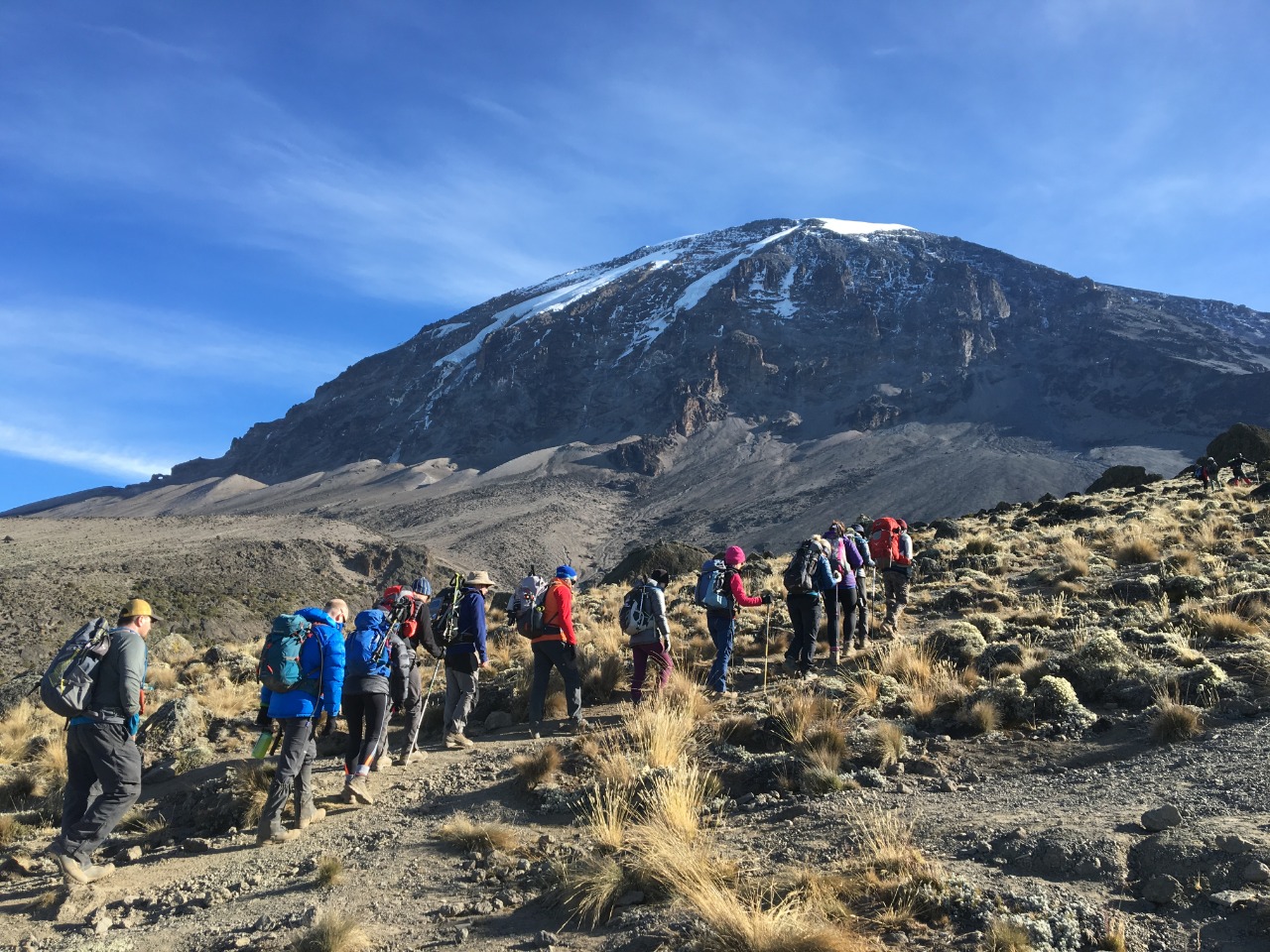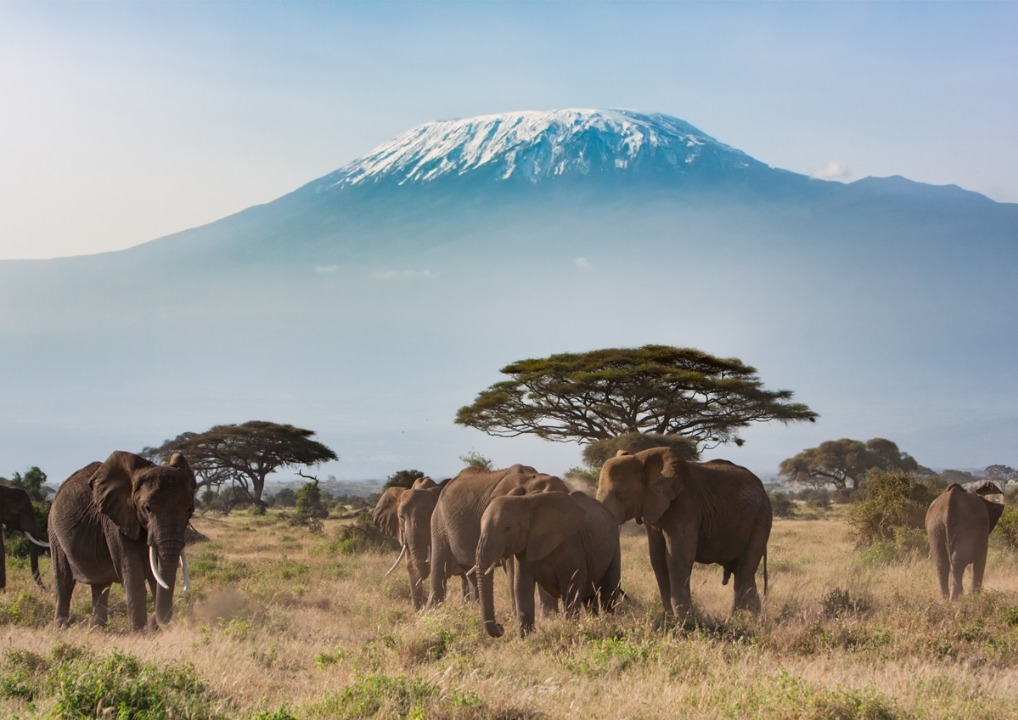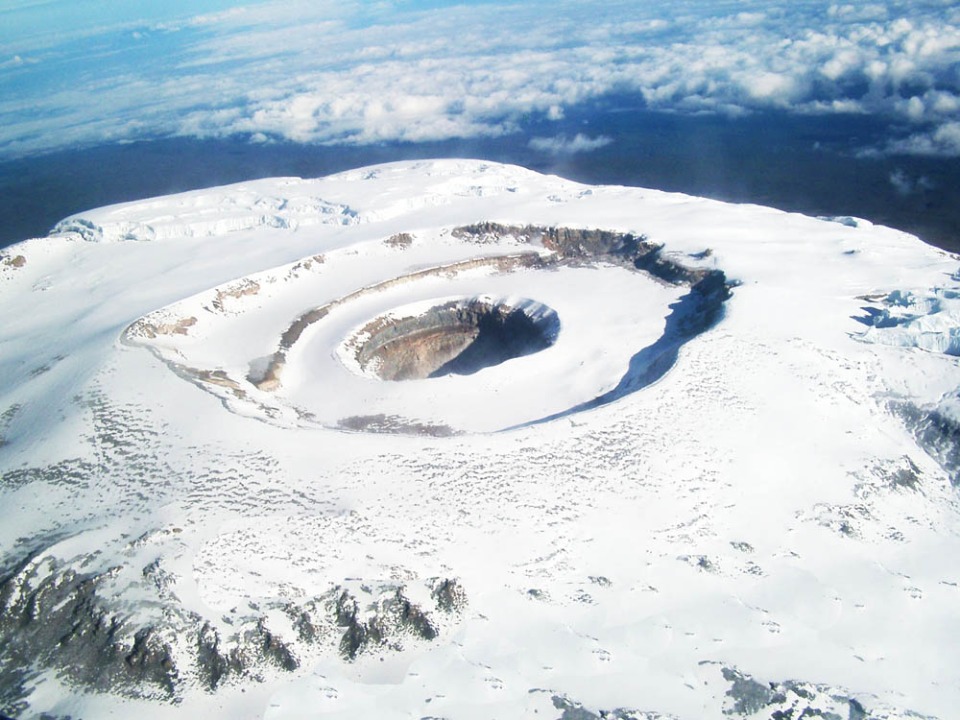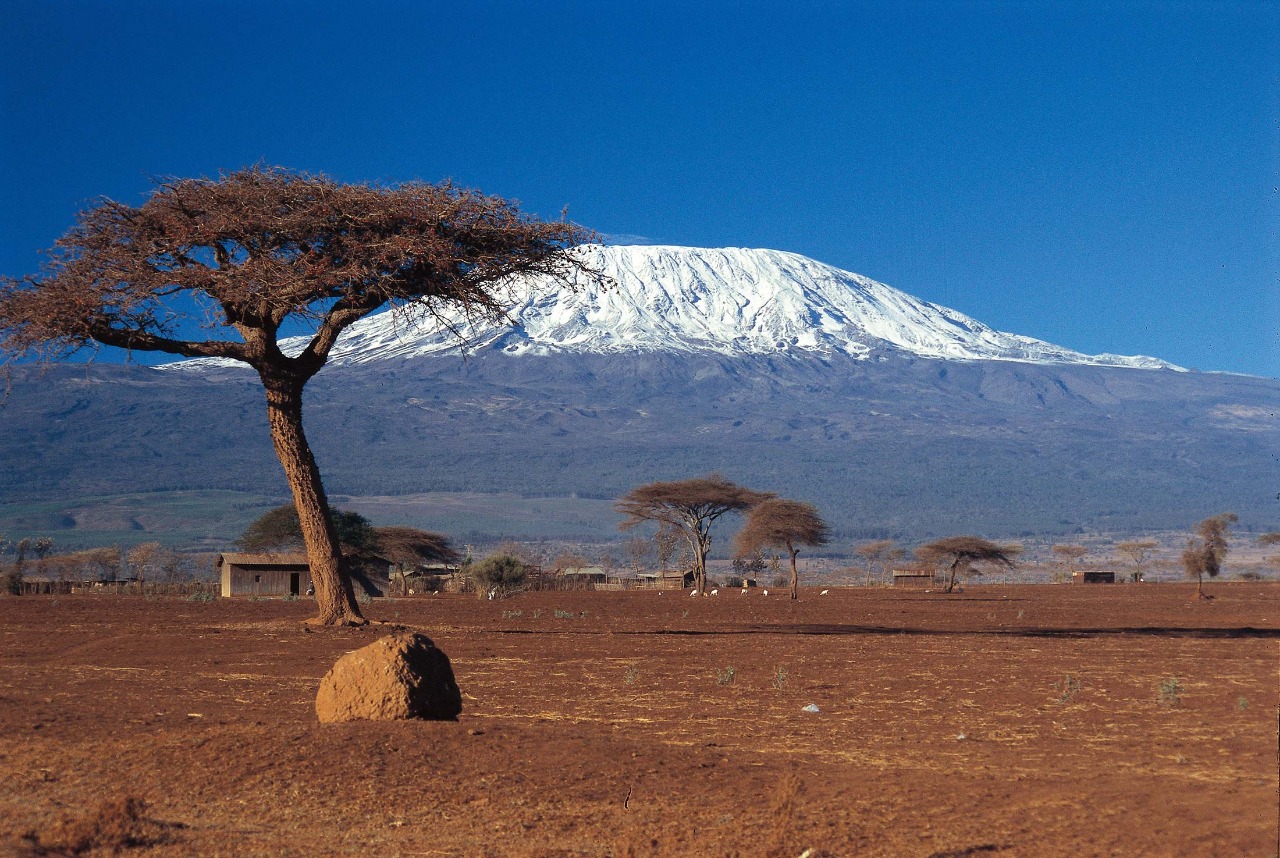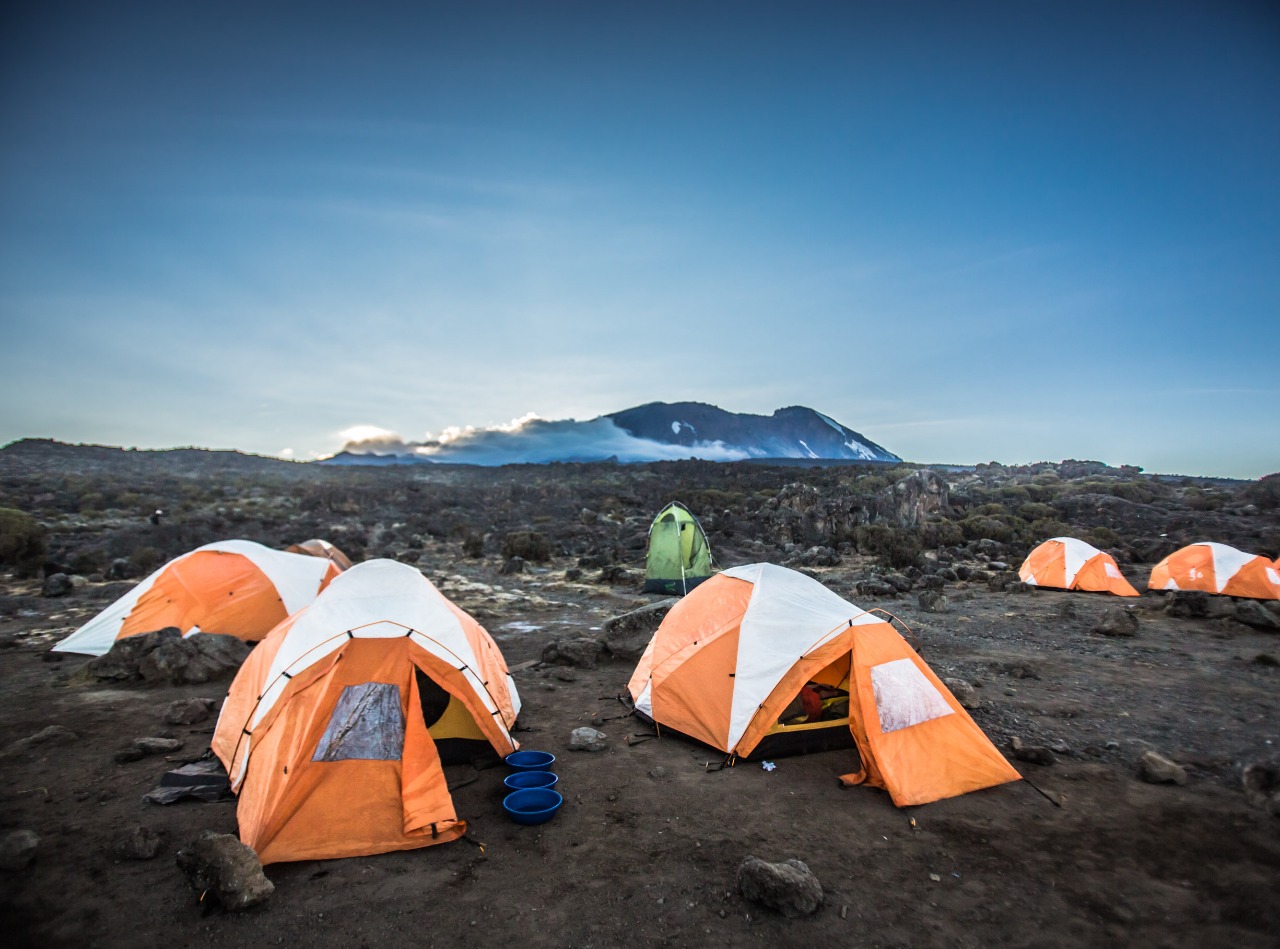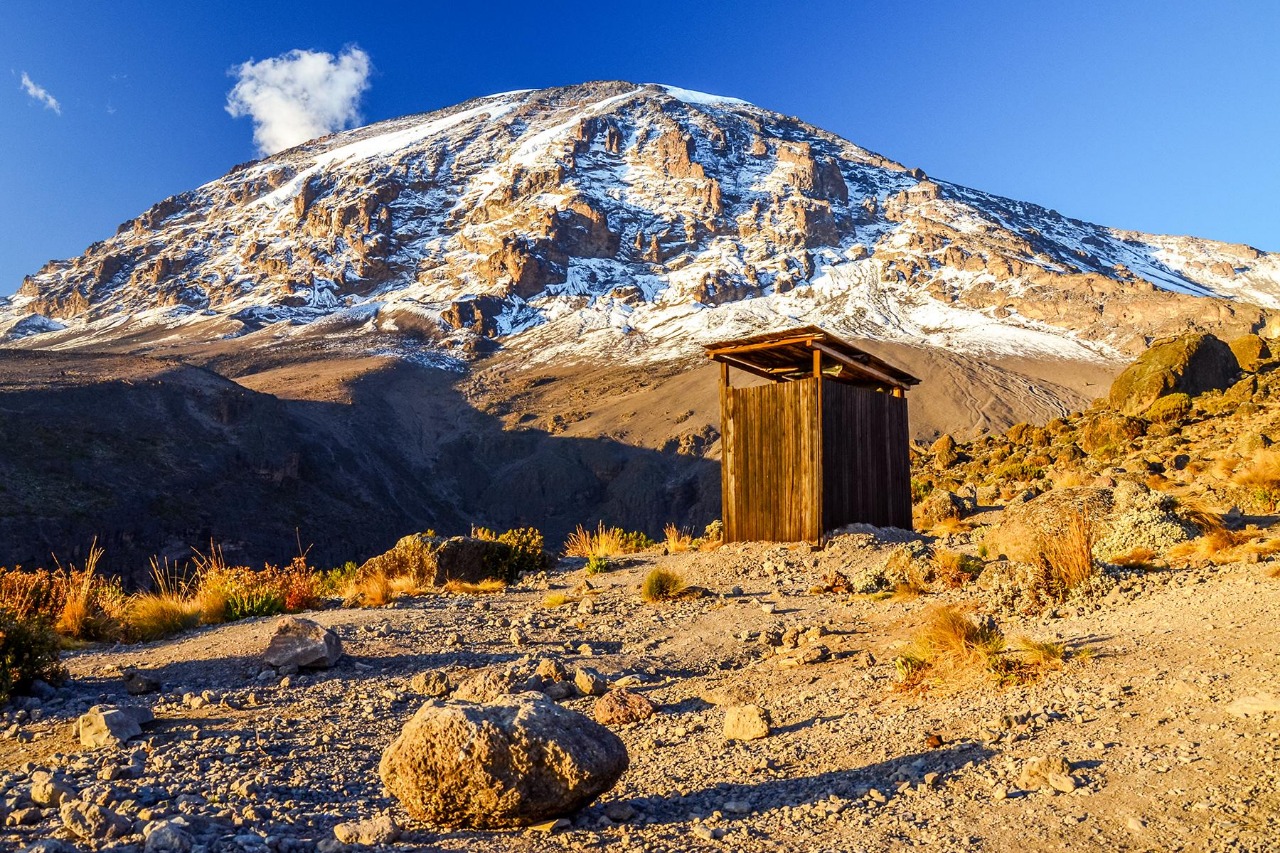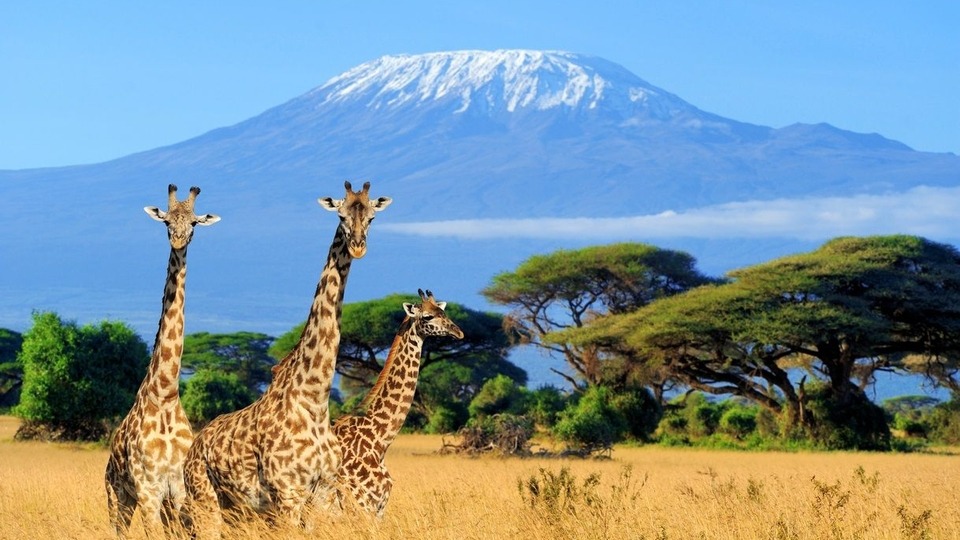Fotos de: Kilimanjaro
Mapa localización
Aeropuertos
Hoteles y otros alojamientos
Qué visitar
World Nomads
El seguro de viaje con la mayor cobertura.

El seguro de viaje con la mayor cobertura.

Kilimanjaro
Mount Kilimanjaro or Mount Kilimanjaro (Oldoinyo Oibor, which means white mountain in Masai, or Kilima Njaro, a shining mountain in Kiswahili), is located in northern Tanzania, bordering Kenya, and is the highest point in Africa. an altitude of 5,895m at Uhuru Peak. This ancient volcano, with its snow-covered top, stands in the middle of a savanna plain, offering a unique spectacle.
The mound and the surrounding forests, with an area of 75,353 hectares, have a rich fauna, including many endangered species and constitute a national park that has been registered by the United Nations Educational, Scientific and Cultural Organization (UNESCO ) in 1987 in the list of sites that are World Heritage.
The mound and the surrounding forests, with an area of 75,353 hectares, have a rich fauna, including many endangered species and constitute a national park that has been registered by the United Nations Educational, Scientific and Cultural Organization (UNESCO ) in 1987 in the list of sites that are World Heritage.
Tourism
Located in northeastern Tanzania, this magnificent mountain can be seen from afar from Kenya to the Amboseli National Park.
75,000 people climb Kilimanjaro a year, so it's not the most remote, nor the most arduous mountain, but it's certainly a test of the skills of someone who likes altitude.
Climbing the Kilimanjaro
One of the most amazing aspects of the mountain these days is the accessibility of its peak for climbers with mountaineering equipment or actual previous experience of climbing these heights. Kilimanjaro is the highest mountain that regular tourists can climb, although it remains a considerable feat of human endurance!
The breathable oxygen at the top is less than half the amount that is common at sea level, and climbers have to do at least eighty kilometers using nothing more than their own feet over the five days it takes to reach the top and return .
Due to the annual increase in tourists intending to climb the mountain, taking into account the preservation of nature passes are no longer issued at the last minute at the gate of the park. It is necessary to make the reservation in advance.
- General adequacy required
While it is possible to simply navigate a route to the Kibo Pinnacle without relying on professional climbing equipment, it remains a difficult and serious endeavor requiring a level of physical conditioning, endurance and a realistic perception of the harmful effects of high altitudes.
Many tour operators request that clients consult their doctor before attempting to climb the mountain and perform a physical check-up for general fitness.
- Phases of the Ascent;
The first experience of the mountainous environment begins with the dense vegetation of the tropical forest between 1850 and approximately 2800m.
The condensation of the clouds is mainly concentrated around the forest, so this area is usually humid or soaked with rain.
At around 3,200m, a vast stretch of moorland extends beyond the cloud line, so that the skies are usually clear, making the sunlight intense during the days and cool and clear at night.
The slope of the climb remains soft, but oxygen begins to be thinner and can drastically slow down the pace.
Above the 4 000 meters comes the Alpine desert, with a more dispersed vegetation.
This sensation intensifies as the landscape becomes a more bizarre alpine desert with sandy soil and intense weather conditions and temperature fluctuations so dramatic that almost no species of plant survives, as well as flowers, mosses and eternal lichens. Only the strange lichen survives more than 5000 meters, past the Kibo Huts and beyond the Saddle, where the landscape is predominantly rocks and ice fields. Here, climbers experience the final push to the summit.
Saddle for the Summit
The east, Marangu, Mweka, Loitokitok and Rongai routes all converge to the west of the saddle near Gillmans Point, between the peaks of Mawenzi and Kibo. The Kibos crater is approximately circular, with an inner cone extending up to 5,800m, (100m below the summit of Uhuru Peak).
In the center, an inner crater with walls between 12 and 20 m high contains another smaller concentric cone, whose center falls within 360 m of the ash pit. This is the 120-meter-deep core of the volcano, and it launches sulfurous boiling smoke from its depths, despite its frozen and snowy surroundings.
75,000 people climb Kilimanjaro a year, so it's not the most remote, nor the most arduous mountain, but it's certainly a test of the skills of someone who likes altitude.
Climbing the Kilimanjaro
One of the most amazing aspects of the mountain these days is the accessibility of its peak for climbers with mountaineering equipment or actual previous experience of climbing these heights. Kilimanjaro is the highest mountain that regular tourists can climb, although it remains a considerable feat of human endurance!
The breathable oxygen at the top is less than half the amount that is common at sea level, and climbers have to do at least eighty kilometers using nothing more than their own feet over the five days it takes to reach the top and return .
Due to the annual increase in tourists intending to climb the mountain, taking into account the preservation of nature passes are no longer issued at the last minute at the gate of the park. It is necessary to make the reservation in advance.
- General adequacy required
While it is possible to simply navigate a route to the Kibo Pinnacle without relying on professional climbing equipment, it remains a difficult and serious endeavor requiring a level of physical conditioning, endurance and a realistic perception of the harmful effects of high altitudes.
Many tour operators request that clients consult their doctor before attempting to climb the mountain and perform a physical check-up for general fitness.
- Phases of the Ascent;
The first experience of the mountainous environment begins with the dense vegetation of the tropical forest between 1850 and approximately 2800m.
The condensation of the clouds is mainly concentrated around the forest, so this area is usually humid or soaked with rain.
At around 3,200m, a vast stretch of moorland extends beyond the cloud line, so that the skies are usually clear, making the sunlight intense during the days and cool and clear at night.
The slope of the climb remains soft, but oxygen begins to be thinner and can drastically slow down the pace.
Above the 4 000 meters comes the Alpine desert, with a more dispersed vegetation.
This sensation intensifies as the landscape becomes a more bizarre alpine desert with sandy soil and intense weather conditions and temperature fluctuations so dramatic that almost no species of plant survives, as well as flowers, mosses and eternal lichens. Only the strange lichen survives more than 5000 meters, past the Kibo Huts and beyond the Saddle, where the landscape is predominantly rocks and ice fields. Here, climbers experience the final push to the summit.
Saddle for the Summit
The east, Marangu, Mweka, Loitokitok and Rongai routes all converge to the west of the saddle near Gillmans Point, between the peaks of Mawenzi and Kibo. The Kibos crater is approximately circular, with an inner cone extending up to 5,800m, (100m below the summit of Uhuru Peak).
In the center, an inner crater with walls between 12 and 20 m high contains another smaller concentric cone, whose center falls within 360 m of the ash pit. This is the 120-meter-deep core of the volcano, and it launches sulfurous boiling smoke from its depths, despite its frozen and snowy surroundings.
Weather
Due to Mount Kilimanjaro's proximity to the equator, this region does not experience the extremes of winter and summer weather, but rather dry and wet seasons. January and February are the warmest months, April and May are the wettest months, June and July are the coolest months, and August and September are the driest months. January, February, and September are considered to be the best months to climb Kilimanjaro in terms of weather.
The journey from the gate to the peak is like traveling from the equator to Antarctica in a matter of days. This is because the routes to the Uruhu peak cross different ecological zones. Throughout the climb, temperatures vary considerably with the altitude and time of day. Mount Kilimanjaro has five major ecological zones, each approximately 3,280 feet (1,000 m) in altitude. Each zone is subject to a corresponding decrease in rainfall, temperature and life as the altitude increases. At the beginning of the climb, at the base of the mountain, the average temperature is around 70 ° F to 80 ° F (27 ° C to 32 ° C). From there, the temperatures will decrease as you move through Mount Kilimanjaro's ecological zones. At the summit, Uruhu Peak, the night time temperatures range from 0 ° F to -15F (-18 ° C to -26 ° C). Due to Mount Kilimanjaro's great height, the mountain creates its own weather. It is extremely variable and impossible to predict. Therefore, regardless of when you climb, you should always be prepared for wet days and cold nights.
The journey from the gate to the peak is like traveling from the equator to Antarctica in a matter of days. This is because the routes to the Uruhu peak cross different ecological zones. Throughout the climb, temperatures vary considerably with the altitude and time of day. Mount Kilimanjaro has five major ecological zones, each approximately 3,280 feet (1,000 m) in altitude. Each zone is subject to a corresponding decrease in rainfall, temperature and life as the altitude increases. At the beginning of the climb, at the base of the mountain, the average temperature is around 70 ° F to 80 ° F (27 ° C to 32 ° C). From there, the temperatures will decrease as you move through Mount Kilimanjaro's ecological zones. At the summit, Uruhu Peak, the night time temperatures range from 0 ° F to -15F (-18 ° C to -26 ° C). Due to Mount Kilimanjaro's great height, the mountain creates its own weather. It is extremely variable and impossible to predict. Therefore, regardless of when you climb, you should always be prepared for wet days and cold nights.
Otros destinos turísticos en:
Tanzania
Tanzania
Otros destinos turísticos mundiales
¿Por qué reservar con TOURISTIC ROUTES
Los mejores precios
Nuestras asociaciones con los operadores más grandes del mundo ofrecen una busca sobre los mejores precios del mercado.
Mas opciones
En Rotas Turisticas puede reservar el hotel, comprar el boleto aéreo, reservar el traslado desde el aeropuerto hasta el hotel y viceversa, reservar las excursiones locales, alquilar el automóvil, contratar un seguro de viaje y consultar los lugares para visitar y dónde ir.
Destinos de vacaciones
Cientos de destinos de vacaciones con todas las opciones que le permiten elegir fácilmente el destino que mejor se adapte a las vacaciones de sus sueños.
TOURISTIC ROUTES
Links

